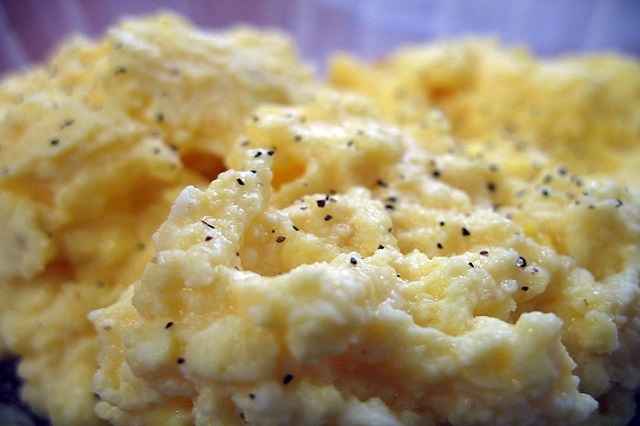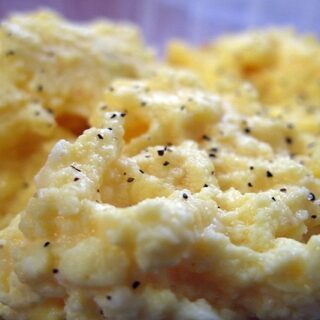Are you tired of your scrambled eggs turning out dry, rubbery, or just plain boring? Look no further!
In this guide, I will take you through the step-by-step process of mastering the art of scrambled eggs.
Create a quick healthy meal with loads of flavour and packed with protein using this recipe for scrambled egg.
This is one of the most popular ways to serve eggs for any meal.
Who doesn’t love perfect fluffy, moist, flavourful and evenly cooked egg scramble.
Take this this basic recipe and take it to rhe next level.
How To Make Perfect Scrambled Egg
Learn how to make the best scrambled eggs with this step-by-step guide.
From whisking to cooking, we've got you covered.
Start your day off right with delicious scrambled eggs!
Take this meal and transform it into an incredible dish.
From whisking to cooking, we've got you covered.
Start your day off right with delicious scrambled eggs!
Take this meal and transform it into an incredible dish.
Equipment
- Small bowl
- Whisk
- Spatula
- Non-stick skillet or frying pan
Ingredients
- 2 Eggs
- 2 Tbsp milk
- 2 tsp butter
- salt to taste
- black pepper to taste
Instructions
Prepare the eggs:
- Crack 2 Eggs into a mixing bowl.
- Add the 2 Tbsp milk and salt.
- Using a whisk or fork, whisk the mixture until foamy.
Cooking:
- Melt the 2 tsp butter in a frying pan on medium heat.
- Pour egg mixture into frying pan.
- Stir mixture with spatula to break up the egg as it cooks and allow more liquid to touch the hot pan.
- For larger curds; For larger curds scoop the eggs in towards the middle of the pan as they set, this will make larger curds.
- For finer curds; To create a finer curd the egg mixture is stirred very thoroughly during cooking to give a soft, fine texture.
- Cook until just before you feel that they are done, since the eggs will continue to cook after being removed from the pan.
- The eggs are done when the sheen disappears; stop cooking just before this happens.
Serving:
- Transfer to a plate.
- Season with black pepper to taste.
Video
Notes
Tips and tricks for elevating your scrambled eggs.
While the basic steps outlined above will yield delicious scrambled eggs, here are some additional tips and tricks to take your breakfast to the next level:
- Use cream instead of milk:
- For an extra creamy and luscious scramble, add thickened cream to the beaten eggs. This will create a richer and more indulgent texture.
- Don't forget the salt:
- Salt is a crucial ingredient in scrambled eggs, as it enhances the natural flavours and helps bring out the creaminess. Be sure to season the eggs with salt before cooking. However, avoid adding salt too early, as it can draw out moisture and result in watery eggs.
- Experiment with herbs and spices:
- While salt and pepper are the classic seasonings for scrambled eggs, don't be afraid to experiment with different herbs and spices. Dried or fresh herbs like thyme, basil, or dill can add a burst of flavour. Spices like paprika, cayenne pepper, or turmeric can lend a unique and aromatic twist.
- Add a touch of acid:
- A small squeeze of lemon juice or a dash of vinegar can brighten up the flavours of your scrambled eggs. The acidity cuts through the richness and adds a refreshing tang.
- Try adding cheeses:
- Cheese and eggs are a match made in heaven. Try adding crumbled feta, goat cheese or Gruyère to your egg mixture, there's a cheese for every taste. Experiment with different varieties to discover your favourite combination.
- Get creative with mix-ins:
- Don't limit yourself to traditional, try adding mix-ins like vegetables and meats. Consider adding unexpected ingredients like smoked salmon, truffle oil, or avocado for a gourmet twist.
- Make it colourful:
- Consider Incorporating a rainbow of vegetables into your scrambled eggs for a vibrant and nutritious meal. Diced capsicum/bell pepper, spinach, tomatoes, and zucchini are just a few examples of colourful additions.
What To Have With Scrambled Egg
Ok, so you've got a plate of beautiful fluffy scrambled eggs and you're after some ideas on how to serve and what to eat with them. I'll start with, "They're great for breakfast, brunch, lunch or dinner, in fact any light meal.- Sausage and Egg lunch muffin;
- How to make a sausage and scrambled egg muffin. Lightly toast a split English muffin, then build with a sausage meat patty, your egg, a slice of cheese and sliced tomato or tomato relish. It's better than McDonalds.
- Grilled tomatoes and toast:
- It goes great with grilled/broiled tomatoes and buttered toast.
- Buttered toast with Vegemite or Marmite:
- A popular NZ, Aussie and UK favourite is to serve over buttered toast with Vegemite or Marmite.
- Scrambled eggs with bacon;
- Ideal with a side of bacon and toasted muffins.
- Big breakfast:
- Turn it into a big breakfast and have your fluffy eggs with sausages, bacon, mushrooms, tomatoes and hash browns.


I made cheesy scrambled eggs perfectly using this recipe.
I live on eggs. This recipe makes perfect scrambled eggs. Loved the savoury one.
I was searching for a sure fire way of preparing eggs for new guests. I knew mine could use improvement. My practice run this morning was amazing. Easy! Fluffy! Flavourful!
There are some very good scrambled egg ideas here